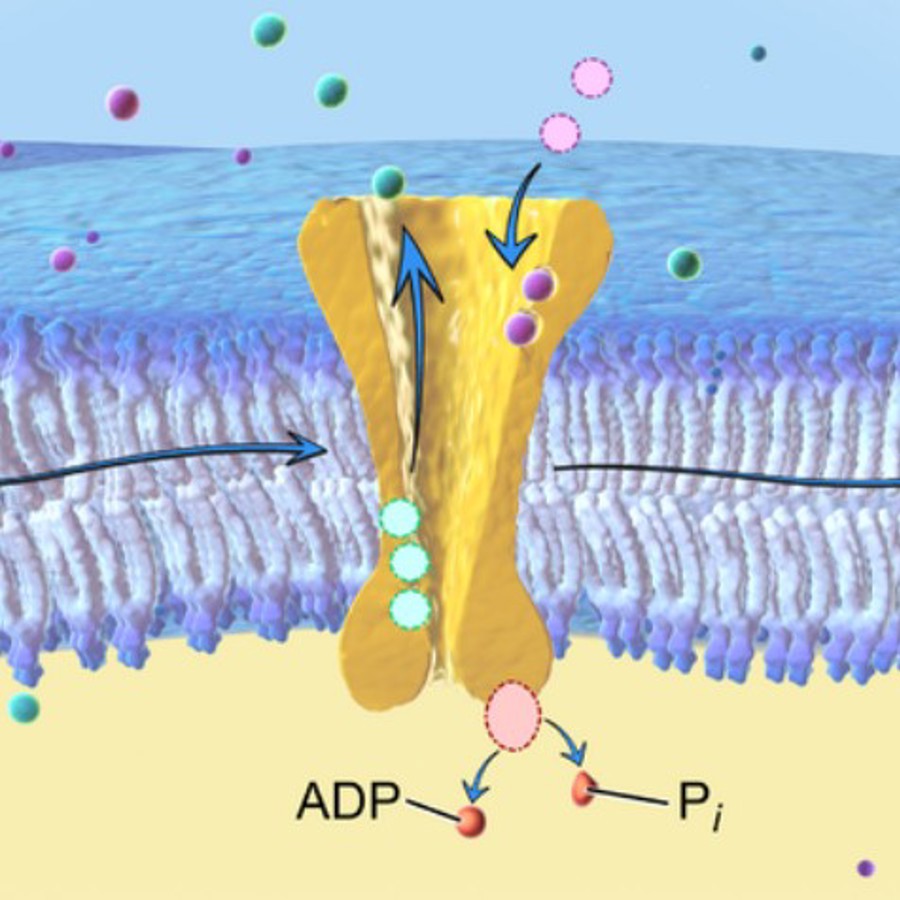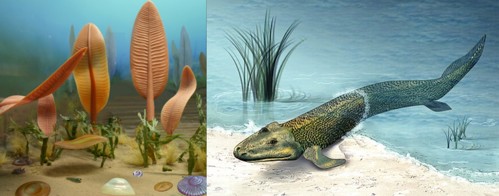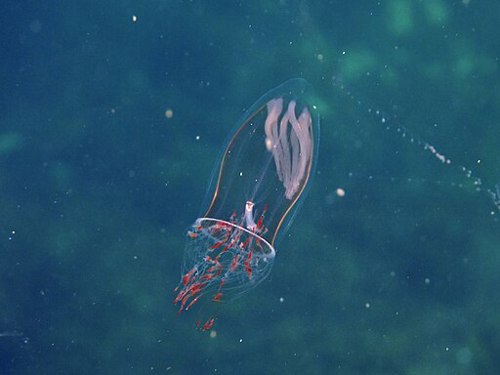
How can complex biological processes like the sodium potassium pump exist through evolution?
July 29, 2025

- Related Topics:
- Evolution,
- Cell biology,
- Molecular biology
A college student from Turkey asks:
"How can complex biological processes like the sodium potassium pump, which involves a neuron integrating sodium and potassium ions into its body, or metabolic processes like the Calvin and Krebs cycles, exist through evolution, which is just a process of trial and error?"
In 1959, Danish biochemist Jens Christian Skou discovered the sodium-potassium pump in the membranes of crab neurons. He would go on to receive (half of) the Nobel Prize in Chemistry almost 40 years later, in 1997. But the sodium-potassium pump is a lot older than that! If you’ve heard of this famous pump, you’ve probably heard about the role it plays in brain signals. It might surprise you, then, that it likely evolved in microorganisms without brains (let alone multiple cells!).1
To make a very, very long story short, the earliest cell membranes became increasingly complex over time. Eventually, they included special proteins like the sodium-potassium pump, which our brains adapted for neuronal signaling. Read on to learn more about the ancient origins of this key membrane pump.
Setting boundaries: The cell membrane
The cells in our bodies share an ancient problem with single-celled microorganisms: They have to keep the water that surrounds them from flooding in. Cells must maintain a stable volume in order to work properly. They solve this problem with their membrane, which controls the movement of water and small molecules into and out of the cell.
All of our cells are surrounded by a special membrane called a lipid bilayer, which is made up of two sheets of molecules stacked on top of each other. Each of these molecules has a head that is attracted to water and a tail that is repelled by it. The heads of the top layer face the watery extracellular environment, and the heads of the bottom layer face the (also watery) intracellular environment. This means that the water-repelled tails of the top and bottom layers face each other, forming a core sandwiched between the heads. As a result, water and other molecules can’t easily cross the core into or out of the cell.
How, then, do cells get important molecules and nutrients across the membrane? Our cells use specialized proteins to transport these particles across the membrane, but this wasn’t always the case.
When meteorites and comets bombarded the Earth around 4 billion years ago, they brought the elements that made the organic molecules needed for cellular life.2 Astrobiologists think that molecules with water-attracting and water-repelling properties spontaneously came together to form the earliest membranes.
These early membranes were leaky enough to let in charged particles called ions, but not so leaky that they couldn’t trap bigger molecules, like DNA and enzymes. Over time, these membranes evolved more complex transport systems, such as specialized proteins that controlled the movement of ions and other molecules.3
One example of a specialized membrane protein is an ion pump. These pumps are able to recognize certain ions, so only those ions can cross the membrane into or out of the cell. These pumps require energy (in the form of ATP) to do their job. In other words, they don’t work for free! The most common ion pump in our bodies is the sodium-potassium pump. This pump recognizes sodium (Na+) and potassium (K+) ions and controls their movement across the membrane.
How does the sodium-potassium pump work?

You can think of the sodium-potassium pump as a bouncer at a nightclub kicking 3 people out for every 2 they let in, and charging a fee of 1 ATP molecule for each of these couples that enters. Through the process of osmosis, water inside the cell follows the Na+ molecules out, and this keeps the cell from swelling or bursting from the water coming in. In this way, the pump helps the cell maintain a stable volume.
Since more positive ions leave the cell than enter it, this also means that the inside of the cell becomes more negative than the outside. This difference in charge between the inside and outside of the cell is known as an ionic gradient, and it’s critical for the electrical signals your brain uses. We’ll return to this in a bit.

An important feature of the sodium/potassium gradient across the cell membrane is that it holds a stash of potential energy. Just like a stretched rubber band, or a bike at the top of a hill, sodium ions gathered on the outside of the cell wait patiently to rush into the cell, where they are less concentrated. The process of moving down their gradient from the outside of the cell to the inside releases energy. This energy is used to power the movement of other important molecules, like glucose, which are too big to enter the cell on their own. Once inside the cell, glucose can be broken down for energy. In this way, cells use the sodium-potassium pump to fuel processes, like energy production, that are necessary for cell growth, development, and, ultimately, evolution.
How did the sodium-potassium pump evolve?
What’s so special about Na+ and K+ ions specifically? A big clue lies in the sea, where the first animals evolved more than half a billion years ago. As you may have guessed from its salty taste, seawater contains both Na+ and K+ ions, making these ions ideal choices for a gradient-producing pump.

Some 100 million years later, when atmospheric oxygen increased and animals made their way onto land, they brought the sea with them: Although access to Na+ ions was more limited on land, animals maintained high concentrations of Na+ in their extracellular fluids through their diets.1 (Perhaps this is why we have an innate desire for salty foods!) As animals evolved, their metabolic processes became more complex (see the Read More section below), but the sodium-potassium pump remained present across species over time.
Still, you might be thinking, What does any of this have to do with brains?
What has the sodium-potassium pump got to do with brains?
Although it is hard to say for certain, some scientists think that animals evolved nervous systems 635-541 million years ago.4,5 Neurons, the cells of the nervous system, likely evolved from epithelial cells, which make up our skin and line our digestive tracts. Evidence for this comes from the observation that jellyfish epithelial cells generate electrical signals called action potentials. These electrical signals are the basic unit of communication between neurons. And they require the presence of an old friend: the sodium-potassium pump. Let’s briefly discuss what happens during an action potential in the jellyfish Aglantha digitale.
Though they don’t have brains, jellyfish can sense and respond to light, touch, and gravity. Inside their umbrella-shaped bell, jellyfish have nerve rings, which contain giant neurons. At rest, a jellyfish giant neuron is more negative on the inside of the membrane than the outside, thanks to the work of the sodium-potassium pump. When something touches the tentacles of the jellyfish, the membrane of the giant neuron becomes more positive as sodium ions move into a part of the neuron called the axon. This in turn triggers a muscle signal that leads to the contraction of the umbrella-shaped bell, which generates a jet of water that propels the jellyfish in its fast escape from a predator.

This reversal of membrane charge to communicate information about the environment and produce the right behavioral responses is at the heart of an action potential. It’s one of the most important signals our neurons use to communicate with each other and our muscle cells. Our brains have adapted action potentials for far more complex behaviors than running away from predators, but the basis of an action potential--the ionic gradient maintained by the handy sodium-potassium pump--remains the same. And we owe it to the humble microorganisms whose clever membrane tricks have been conserved through billions of years of evolution.

Author: Deniz Bingul
When this answer was published in 2025, Deniz was a Neurosciences PhD candidate, studying cognitive function in a mouse model of Parkinson’s disease. Deniz wrote this answer while participating in the Stanford at The Tech program.
 Skip Navigation
Skip Navigation
